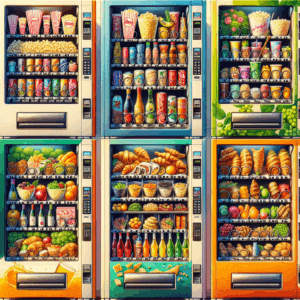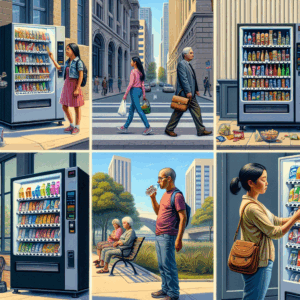User-Friendly Vending Machine Design
Understanding Customer Needs
When it comes to designing a user-friendly vending machine, the first step is putting yourself in the customer’s shoes. I often start by considering what customers typically look for when they approach a vending machine. Is it ease of use, or maybe a diverse range of products? Identifying these needs helps in designing a machine that serves its purpose effectively.
The layout of a vending machine can greatly affect its usability. Opt for clear and concise product displays and labeling. Customers appreciate transparency and ease when making their selections, which sometimes boils down to straightforward and accessible packaging display.
Last but not least, think about accessibility. It’s crucial to design machines that cater to all users, including those with disabilities. This can involve ensuring buttons are within easy reach and adding Braille for the visually impaired. Making a machine accessible isn’t just ethical; it’s great business.
Intuitive Interface Design
A vending machine with an intuitive interface can drastically reduce user frustration. When designing such an interface, simplicity is key. A clutter-free interface with straightforward icons and instructions can guide users smoothly through their purchase.
You’ve probably encountered vending machines with touchscreens that seem overly complex. From personal experience, the more options you provide, the more confusing it becomes. Stick to the essentials and ensure users can make selections with minimal steps.
Another tip is incorporating a responsive feedback system. For instance, providing sound cues or visual alerts like LED lights when items are chosen ensures users know their actions have been registered, mitigating any confusion or mistakes.
Ergonomically Designed Machines
Ergonomics play a significant role in user-friendly vending machine design. Pay attention to the physical interactions people have with the machine. This might seem like a no-brainer, but you’d be surprised how often it’s overlooked!
Start by checking the height of the machine—ensure it’s suitable both for the average adult and accessible to children or those with disabilities. Incorrect height can result in negative customer experiences, which none of us want.
Additionally, consider the distance at which products dispense and the angle at which buttons are placed. All these factors contribute to the ease—or difficulty—of a customer’s interaction with the vending machine. Remember, the goal is to make the experience as seamless as possible.
Reliable Vending Machine Technology
Investing in Quality Hardware
In my experience, investing in good quality hardware pays off tenfold. The reliability of a vending machine largely depends on the components used. No one wants a machine that swallows coins or dispenses the wrong item.
Choose components that are compatible and have a proven track record. It’s not just about the initial setup cost but considering the long-term savings on repairs and maintenance. A robust machine not only saves money but also ensures customer satisfaction.
Durable hardware parts, such as motors and sensors, reduce the likelihood of faults. Keep maintenance in mind—we’ll get into strategies for that shortly—but remember, prevention is always better than fixing problems down the line.
Implementing Advanced Software Solutions
Having advanced software to control vending machine operations is just as crucial as quality hardware. Simple software can streamline operations, while state-of-the-art programs can revolutionize the customer experience.
I would suggest looking into adaptive software that can analyze customer behavior and adjust inventory automatically. This level of intelligence minimizes human oversight and ensures stock levels are maintained without manual input, thus preventing stock-outs.
Software that facilitates easy troubleshooting is another must-have. Ideally, you want a system that sends error alerts directly to your phone or computer, allowing you to address issues ASAP. Minimizing downtime not only keeps customers happy but avoids potential revenue loss.
Regular System Updates
Gone are the days when we could set up vending machines and leave them be. Now, constant system updates are necessary to keep everything running smoothly. I’ve seen firsthand how outdated software can cause mishaps or even security vulnerabilities.
Simplifying system updates can be as easy as scheduling routine checks and updating software versions. And don’t forget about firmware updates for the hardware components. They’re equally essential to ensure compatibility with new features.
Make sure to keep up with technology trends as well. Infusing the latest tech into your vending machines, like contactless payments or app-driven purchases, can significantly enhance the user experience and set you apart from the competition.
Customer-First Vending Machine Maintenance Strategies
Routine Check-Ups
One vital strategy that I’ve sworn by is routine maintenance checks. Catching problems early can prevent bigger issues down the line. Scheduled check-ups ensure everything from coin acceptors to product delivery mechanisms functions correctly.
By creating a regular checklist of potential problem areas, it becomes easier to stay on top of maintenance tasks. For example, check the integrity of the power source, and any signs of wear and tear on buttons and slots. Addressing these issues promptly avoids machine breakdowns.
Regular cleaning also falls under routine checks. Not only does it keep the machine looking presentable, but it prevents mechanical parts from malfunctioning due to debris or spills. Customers will appreciate a well-kept machine, which reflects positively on your brand.
Proactive Component Replacements
In machine maintenance, a proactive approach is often more effective than a reactive one. Some parts have lifespans which, when ignored, result in unexpected downtimes. I’ve learned to replace components like belts or sensors before they cause any trouble.
By logging the lifespan and usage patterns of parts, you can anticipate when replacements will be necessary. This approach not only reduces surprise failures but maintains the reliability of your machines.
Balancing cost against efficiency is crucial here. While no one wants unnecessary expenses, investing in component replacements at the right time ensures smooth operations and happier customers in the long run.
Customer Feedback Integration
Believe it or not, customers can provide invaluable insights into the health of your machines. Encourage them to provide feedback on their experiences. Often, they’ll inform you of issues that you might not be aware of.
Set up a simple and accessible feedback system, like a QR code that links to a survey or a small form under the machine’s touchscreen. Use this data to improve machine performance effectively.
Responding to feedback also builds customer rapport. They’ll value being heard, and making improvements based on their comments deepens loyalty and encourages repeat usage, which is the ultimate goal.
Effective Complaint Resolution Tactics for Vending Machines
Prompt Customer Service
Handling customer complaints promptly is a no-brainer, yet many businesses falter at this step. I’ve found that acknowledging a customer’s complaint as soon as you receive it goes a long way in smoothing things over.
Utilize automated systems that give immediate responses. Even if full resolution takes time, letting customers know their issues are being addressed keeps them from feeling ignored.
Personal touches, like a live reply or a follow-up call, add a human aspect that’s often missing in digital interactions. These touches show customers that their grievances are taken seriously, which can turn a negative experience into a positive one.
Effective Refund and Compensation Policies
Refunds and compensations seem straightforward, but the policy behind them makes all the difference. Fast and fair compensation policies generally keep customers appeased. I’ve always advocated for a clear-cut, no-hassle refund strategy to keep everyone happy.
Make sure customers are aware of the policies upfront. Display steps on the machine for filing disputes or obtaining refunds, so they know help is readily available if something goes wrong.
Offering small compensatory gestures, like an additional free product, can also placate upset customers and restore loyalty. After all, everyone loves a freebie, right?
Learning from Feedback
This probably sounds like something you’d hear a million times, but feedback is crucial. Use it as a learning tool to prevent future complaints or improve your machines. I’ve found that each piece of feedback is like a little nugget of wisdom.
Regularly summarizing customer complaints can highlight recurring issues. Addressing these not only reduces complaints but demonstrates a commitment to constant improvement, which is key in any business.
Keep an open mind and treat each piece of feedback with importance. Leveraging customer suggestions strengthens your operation and enhances customer satisfaction, ultimately benefiting your whole business model.
FAQ
What is the most common vending machine complaint?
The most common complaint I come across involves payment issues, such as the machine not accepting certain coins or failing to give change. It’s something that can usually be resolved through regular maintenance and updates.
How can I improve vending machine design for better customer experience?
Focus on simplicity and accessibility. Make sure your products are clearly displayed and your interface is user-friendly. Also, consider special needs and ensure your machine is accessible to everyone.
Why is regular maintenance important for vending machines?
Regular maintenance prevents unexpected breakdowns and extends the life of the machine. It ensures each part is functioning properly and can proactively prevent issues, keeping customers happy.
How should I handle customer complaints about vending machines?
Act promptly and maintain open communication. Offer fair refunds or compensations if necessary, and always use complaints to improve your service continually.



